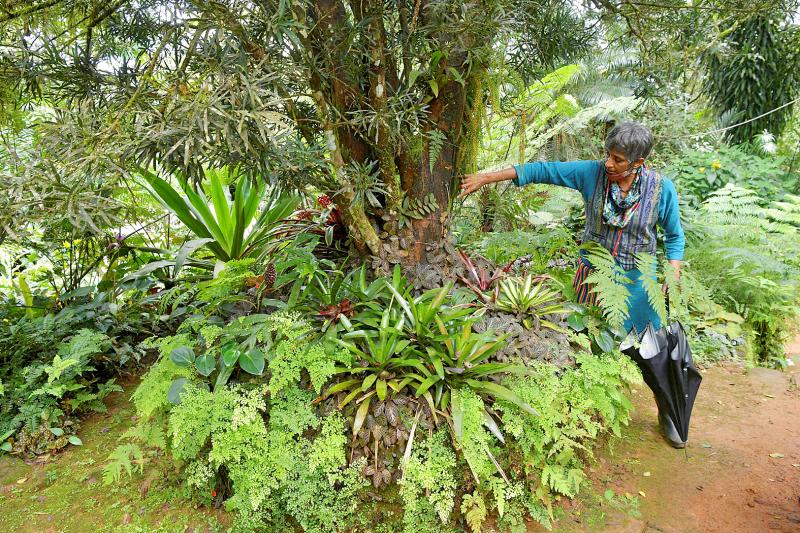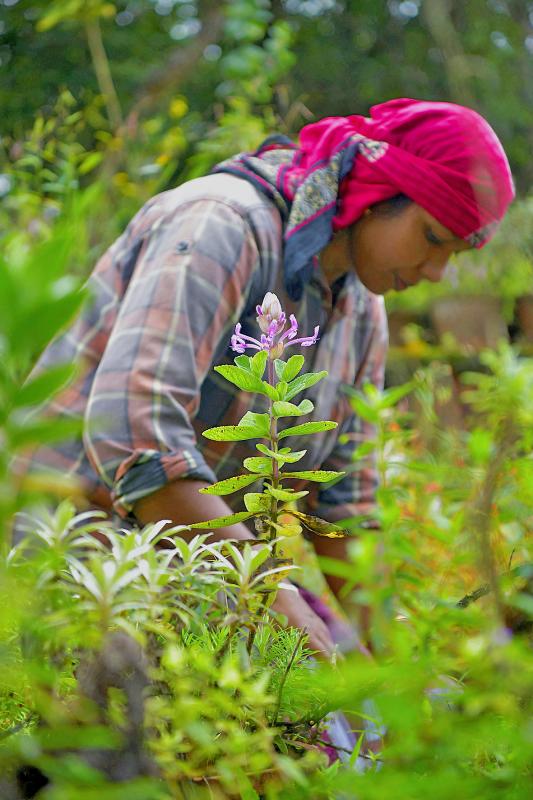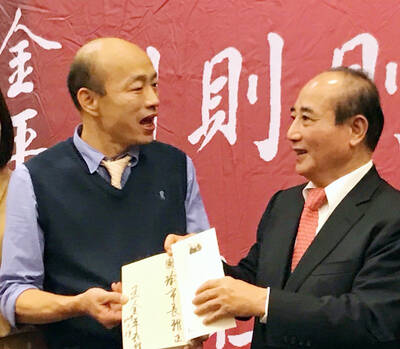As deforestation and climate change ravage India’s UNESCO heritage-listed Western Ghats mountain range, an all-female rainforest force is battling to protect one of the area’s last enclaves of biodiversity.
The region is home to at least 325 globally threatened flora, fauna, bird, amphibian, reptile and fish species but the International Union for the Conservation of Nature has ranked its outlook as a “significant concern.” But at Gurukula Botanical Sanctuary a group of 27 women act as guardians of the rare ferns, tree-hugging mosses and thousands of other plants that may otherwise be lost forever. “We are trying to salvage what is possible. It is like a refugee camp,” said Suprabha Seshan, one of the curators at the reserve.
It is also like a hospital.

Photo: AFP
“The intensive care unit is in the pots and then when you take them out that’s like the general ward where they get other forms of primary health care,” Seshan added.
She estimated that more than 90 percent of the forests once graced the area have disappeared, a situation she describes as an ecological “holocaust.” Gurukula was created as a haven for the native flora struggling for survival because of global warming and human encroachment, in the hope of slowly repopulating the region with indigenous plants. Gurukula, which means a “retreat with a guru” was set up 50 years ago by German conservationist Wolfgang Theuerkauf.
Theuerkauf, who became an Indian citizen in 1978 and died seven years ago, started with seven acres of forest, today it is 10 times that size.

Photo: AFP
‘THIS FOREST IS OUR GURU’
“Wolfgang said ‘this forest is our guru,’” Seshan said.
Three generations of “rainforest gardeners” — women from local villages in the hot and humid Kerala state — have worked with botanists to build up the sanctuary. Dressed in big boots — to protect against cobras and the pitiless insects — and brightly colored tunics, their hair tied under scarves, the women put in long days in the forests, the sanctuary’s greenhouses and its nursery.
They replant the suffering flora, sift compost and seeds and make a malodorous natural pesticide from cow urine.
“We have between 30 and 40 percent of the Western Ghats flora under conservation here,” added Seshan. The work is becoming increasingly crucial.
The region won its UNESCO listing in 2012 in part because it is one of the world’s biodiversity hotspots, but in its 2020 World Heritage Outlook report, the IUCN warned of the threat of encroaching human activity and habitat loss.
It said: “50 million people are estimated to live in the Western Ghats region, resulting in pressures that are orders of magnitude greater than many protected areas around the world.”
Seshan, who has worked at the sanctuary for 28 years, has seen things deteriorate first hand.
“When I came here plastic was still not a part of our culture,” she said. “I remember when Wolfgang found the first plastic bag in the river, he said: ‘civilization has arrived.’”
TRANSPLANT SUCCESS
Fighting off bloodsucking leeches that thrive in the humidity, the rainforest gardeners tend to a multitude of endangered ferns, flowers and herbs that grow around the rocks and in the shade of tropical trees.
The small plants of the Western Ghats are vulnerable to rising temperatures, rainfall fluctuations and the loss of habitat, Seshan said.
“The more the climate changes, the more their reproductive life strategies have to change to adapt.”
Laly Joseph, another of the senior gardeners, scours the mountains for species that need to be moved to Gurukula for intensive care. She tries to find simple ways to reproduce the natural conditions for each species being cared for. It is also carefully listed in an inventory.
Joseph showed off an Impatiens jerdoniae with red and yellow flowers that had been struggling before being nurtured and transplanted on to a tree. Three years on it is thriving.
Joseph, who has worked at the sanctuary for 25 years, says saving a rare species and seeing it live again in a forest is incredibly satisfying.
“They’re happy here, I am happy when they’re happy,” Joseph said of the plant. But she fears the increasingly unpredictable climate may destroy their work. The Western Ghats normally get up to 500 centimeters of rain a year, but the monsoon is increasingly erratic.
The plants are struggling to cope, Joseph said.
“They wilt, they can’t pollinate, they don’t get seeds. That is the way you lose species,” she added. “I suffer when a tree has fallen, when the rainforest dies.”

The depressing numbers continue to pile up, like casualty lists after a lost battle. This week, after the government announced the 19th straight month of population decline, the Ministry of the Interior said that Taiwan is expected to lose 6.67 million workers in two waves of retirement over the next 15 years. According to the Ministry of Labor (MOL), Taiwan has a workforce of 11.6 million (as of July). The over-15 population was 20.244 million last year. EARLY RETIREMENT Early retirement is going to make these waves a tsunami. According to the Directorate General of Budget Accounting and Statistics (DGBAS), the

Many will be surprised to discover that the electoral voting numbers in recent elections do not entirely line up with what the actual voting results show. Swing voters decide elections, but in recent elections, the results offer a different and surprisingly consistent message. And there is one overarching theme: a very democratic preference for balance. SOME CAVEATS Putting a number on the number of swing voters is surprisingly slippery. Because swing voters favor different parties depending on the type of election, it is hard to separate die-hard voters leaning towards one party or the other. Complicating matters is that some voters are

Sept 22 to Sept 28 Hsu Hsih (許石) never forgot the international student gathering he attended in Japan, where participants were asked to sing a folk song from their homeland. When it came to the Taiwanese students, they looked at each other, unable to recall a single tune. Taiwan doesn’t have folk songs, they said. Their classmates were incredulous: “How can that be? How can a place have no folk songs?” The experience deeply embarrassed Hsu, who was studying music. After returning to Taiwan in 1946, he set out to collect the island’s forgotten tunes, from Hoklo (Taiwanese) epics to operatic

Five years ago, on the verge of the first COVID lockdown, I wrote an article asking what seemed to be an extremely niche question: why do some people invert their controls when playing 3D games? A majority of players push down on the controller to make their onscreen character look down, and up to make them look up. But there is a sizable minority who do the opposite, controlling their avatars like a pilot controls a plane, pulling back to go up. For most modern games, this requires going into the settings and reconfiguring the default controls. Why do they